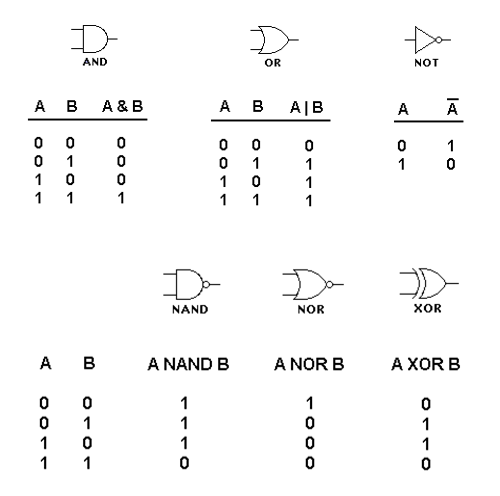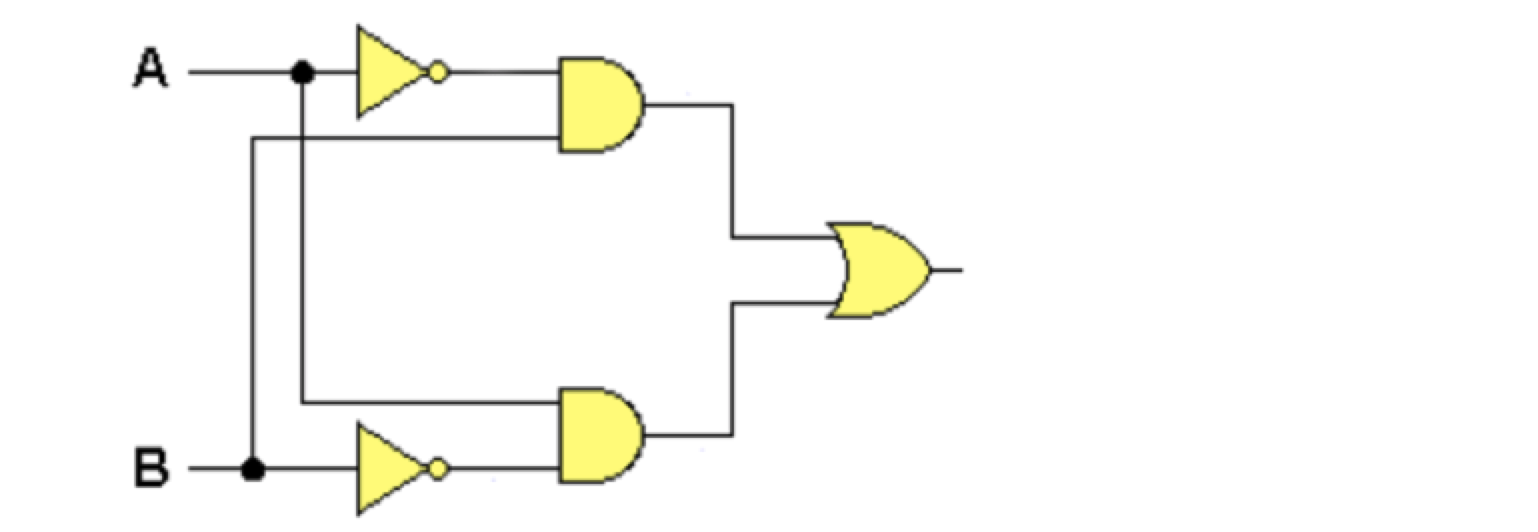View source or report issues on GitHub
Boolean Statements and Logic
As we have seen in earlier notes, a boolean statement is a statement that evaluates to either “True” or “False”.
For each of the following boolean statements, decide if it evaluates to true or false.
- 2 + 2 = 7
- \(\sqrt{49} < 7\)
- It is raining outside right now.
- It is not raining outside right now.
- Mr. Griswold is a teacher and Mr. Griswold is a man.
- Mr. Griswold is a teacher or Mr. Griswold is a man.
- Either Mr. Griswold is a teacher or Mr. Griswold is a man.
Boolean operators
As we saw in problems 4-7, you can take one or two boolean statements and combine them or change them. There are 6 boolean operators we need to know.
NOT
The NOT operator changes a true boolean statement to a false one, and vice versa. So if A is true, then NOT A is false. The programming equivalent in Typescript and Java is the ! operator, as in ! isBlue.
You can represent the behavior of boolean operators with a truth table - the one for NOT is simple:
| A | NOT A |
|---|---|
| T | F |
| F | T |
OR
The OR operator combines two boolean statements. If EITHER of the statements are true, the entire OR statement is true. So 2 = 2 OR 2 = 3 is a true statement. The Typescript / Java equivalent is the || operator, as in x < 0 || y < 0 (which will be true if either value is negative, or both)
For operators like OR that combine two statements, we need a larger truth table.
| A | B | A OR B |
|---|---|---|
| T | T | T |
| T | F | T |
| F | T | T |
| F | F | F |
AND
The AND operator combines two boolean statements and is only true if BOTH of the statements are true, otherwise it is false. So 2 = 2 AND 2 = 3 is a false statement, but 2 = 2 AND 2 > 1 is true. The Typescript/Java equivalent is the && operator, as in x < 0 && y < 0 (only true if both are less than 0)
| A | B | A AND B |
|---|---|---|
| T | T | T |
| T | F | F |
| F | T | F |
| F | F | F |
XOR
The XOR operator stands for exclusive or and it is used in situations we might use the English phrase “either…or” - meaning it is NOT okay for both. We might say “You can have either a cookie OR a brownie”, which is an exclusive or. There is no single XOR operator in java / Typescript, but if you’re sure that a and b are both boolean values, you can “cheat” by realizing that this simply means they are not equal to each other and use a != b to work like XOR.
| A | B | A XOR B |
|---|---|---|
| T | T | F |
| T | F | T |
| F | T | T |
| F | F | F |
NOR
The NOR operator means “NOT OR” and returns the exact opposite of the NOR operator. It is only true if BOTH of the operands are FALSE. So “2 = 2 NOR 2 = 3” is false because one of the statements is true. There is no single NOR operator in java/Typescript, but you can build one combining ! and || like ! (x < 0 || y < 0). (a little thinking will realize this is the same as saying x >= 0 && y >= 0 , which is true - there are usually multiple ways to build complex logical expressions.)
| A | B | A NOR B |
|---|---|---|
| T | T | F |
| T | F | F |
| F | T | F |
| F | F | T |
NAND
The NAND operator means “NOT AND” and returns the opposite of the AND operator. A NAND B is logically equivalen to NOT A OR NOT B and that is usually more common, but we still have to know the NAND operator!
| A | B | A NAND B |
|---|---|---|
| T | T | F |
| T | F | T |
| F | T | T |
| F | F | T |
Building Complex Truth Tables
One required skill for the IB exam is to build truth tables (like the ones above) based on these operators. I will work through an example.
Build a truth table for the statement
(A OR B) OR (B NAND A)
To build these, we start by figuring out our headings, working from the inside out. This always starts with our individual letters that represent individual statements (in this case A and B) and then we work our way outward to the complete statement, doing little middle statements as need be following the order or operations. (These operators all have the same power, so if parenthese don’t make it clear move form left to right).
The first two columns always go “TTFF” and “TFTF” to make all four combinations.
| A | B | B NAND A | A OR B | (A OR B) OR (B NAND A) |
|---|---|---|---|---|
| T | T | |||
| T | F | |||
| F | T | |||
| F | F |
We then build from left to right, following the rules for each operator. NAND the opposite of AND so it is F only when both are True. OR is true whenever either is true.
| A | B | B NAND A | A OR B | (A OR B) OR (B NAND A) |
|---|---|---|---|---|
| T | T | F | T | |
| T | F | T | T | |
| F | T | T | T | |
| F | F | T | F |
Then for the final column, we are applying the OR operator to the two columns I just made! OR is true whenever either of the inputs are true, so the output is…
| A | B | B NAND A | A OR B | (A OR B) OR (B NAND A) |
|---|---|---|---|---|
| T | T | F | F | T |
| T | F | T | F | T |
| F | T | T | F | T |
| F | F | T | T | T |
This statement is always true! Oops, that was a lot of work for a rather simple output!
Order of Operations
Sometimes, the IB will provide you with a logic statement that doesn’t include parentheses, so you have to figure out which order to apply your operations. The rules are:
- NOT goes first, so NOT A OR B is the same as (NOT A) OR B
- AND and NAND go next (left-to right) so A OR B AND C is the same as A OR (B AND C)
- OR, XOR, and NOR go last (left to right) so A OR B XOR C is (A OR B) XOR C but A XOR B OR C is (A XOR B) OR C
Practice problems
Try these examples (bonus: for each one try to come up with a DIFFERENT statement that would have the same result)
-
Create a truth table for the statement
(A NOR B) OR AClick to expand answer
A B A NOR B (A NOR B) OR A T T F T T F F T F T F F F F T T -
Create a truth table for the statement
(A XOR B) AND AClick to expand answer
A B A XOR B (A XOR B) AND A T T F F T F T T F T T F F F F F -
Create a truth table for the statement
NOT (A XOR B)Click to expand answer
A B A XOR B NOT (A XOR B) T T F T T F T F F T T F F F F T -
Create a truth table for the statement
NOT (A OR B)Click to expand answer
A B A OR B NOT (A OR B) T T T F T F T F F T T F F F F T -
Create a truth table for the statement
NOT A AND NOT BClick to expand answer
A B NOT A NOT B NOT A AND NOT B T T F F F T F F T F F T T F F F F T T T
Logic Gates
These logic operators are the primary source of flow control inside of processors. We can make tiny circuits that behave exactly like these operators - we call them logic gates. The image below shows the diagrams for each of the logic gates, as well as their truth tables. IN this format, 0 means False while 1 means True.

In these little circuits, the two pins on the left represent electrical connection points. If the electricity is ON that can be thought of as a 1 or a TRUE input, while if the electricity is OFF that can be thought of as a 0 or FALSE input. The output is either on or off depending on the inputs, following the rules.
You have to learn which gate is which (yes, really).
Sample problems using logic gates
-
Convert the diagram below into a logic statement and calculate the truth table of its output.

Click to expand answer
This is equivalent to
(NOT A AND B) OR (NOT B AND A)which is itself equivalent toA XOR B(either one of these would be accepted as an answer)A B Final Result 1 1 0 1 0 1 0 1 1 0 0 0